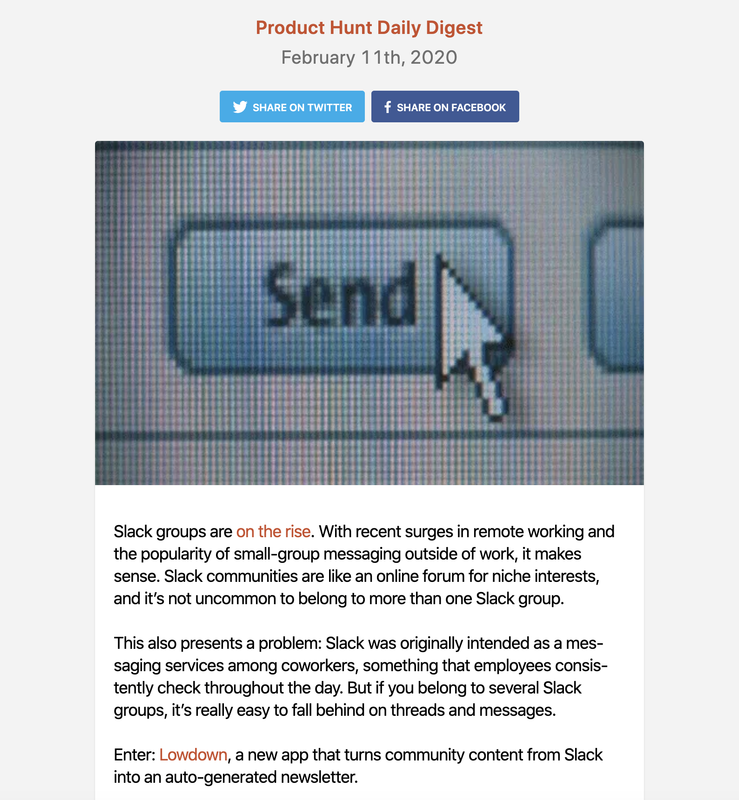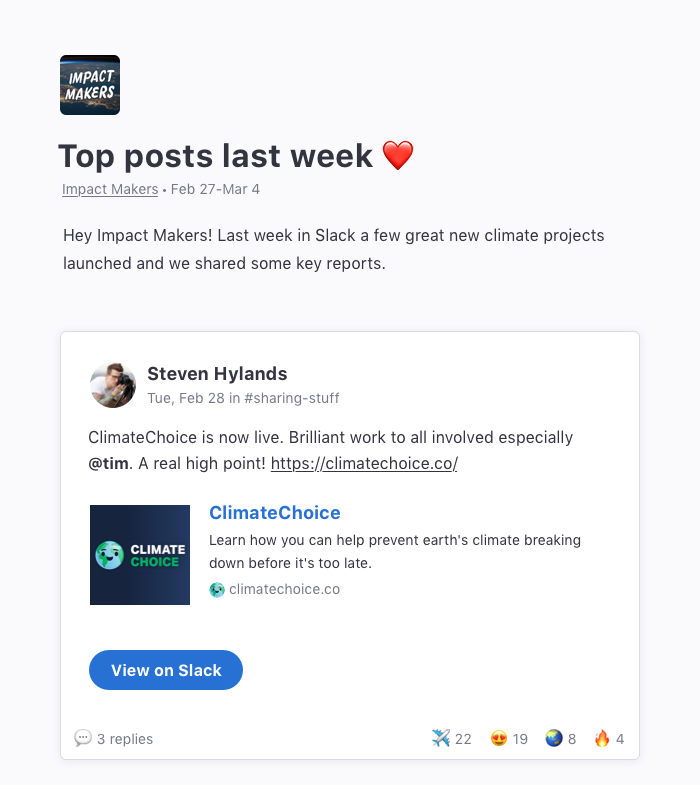Update 5: Learnings from an influx of new users
On 7th February 2020, we launched on Product Hunt finishing 4th for the day, and we were pretty happy with that. Several new users came on board, and we got to test if our current setup could handle a lot of traffic. It did… just about.
However several days later we were featured in the Product Hunt Daily Digest — this is a pretty big deal and leads to a lot more traffic. Over the next few days, more than 100 accounts were created, but regrettably, we weren’t able to maximise on the opportunity due to our technical setup.

Technical difficulties
Lowdown is hosted on Gigalixir — a platform as a service for Elixir apps. The main benefit of a service like it is you can get up and running quickly, enabling you to focus on building the product. Unfortunately, with so much activity in the Lowdown app, it started to crash and on Gigalixir we were we struggling to diagnose the source of the issue.
Phil was essentially holding things together by hand to keep the app live. Despite his efforts, many potential users would have hit an error page upon trying to signup. At this point, we realised we needed to migrate to ensure we had sufficient visibility, ensuring we could spot problems. Two days after the Product Hunt feature, we migrated to Digital Ocean.
As a result, the app was down almost a full day and we likely missed out on several new users. While this wasn’t ideal, we can’t discount the days of work saved by starting out with Gigalixr. It meant we could focus on building a product and validate if there was interest before spending time on structural improvements before they were needed.
Who signed up?
It’s vital to understand who your users are — especially at this early stage when we’ve yet to fully work out who to target. I decided to analyse our new users to learn what type of community or team is interested in a product like Lowdown.
⅓ were communities — the audience which the Product Hunt listing was geared towards. The remaining ⅔’s were different kinds of tech businesses. 70% product teams, 25% agencies, 5% accelerators/incubators.
It was fascinating to see all these different kinds of teams signing up. Still, we need to be cautious as this is heavily skewed by the Product Hunt audience. The key is to learn what problem these teams are trying to solve by registering with Lowdown. So we can determine if it’s the direction we should follow.
Benefits of an influx of users
Getting a lot of people to use your product at once is a great way to quickly learn where the issues are. We had dozens of users chat to us to report bugs, request features, and even tell us precisely what Lowdown would need to do before they would pay for it.
All this feedback gave us a keen insight into where the problems lie, and we were able to plan our Product Roadmap with increased confidence that we’d be working on the right things.
We’ve made this public, check out our roadmap here. Feel free to vote for your favourite features.
Improving the product
We now know our product needs a lot of love. For one it would greatly benefit from an onboarding experience. To date, newly signed up users have been dropped on a screen with a newsletter autogenerated from their public channels and little explanation about what they are looking at. Most of the time, this content is not something they’d want to send, and we’re losing users before they even get started. We’ve realised we need to help them set up their newsletter, so when they see it for the first time, it’s showing content that fits what they’d actually like to deliver to their audience.
Making it look like something that they’d want to send is also of utmost importance — and right now it looks like something from the 90s. We have a redesigned newsletter coming soon. It’s a significant improvement, more visual and newsletter-like.

Our first version was very basic and I’m glad it was. By keeping it simple, we’ve learnt what we need to add to the newsletter to increase it’s value to our users. That’s meant we didn’t waste time upfront building unnecessary features based on guesswork. Instead, we can build additional value based on demand.
We also continued to learn that our Slackbot (which asks users to opt-in to a newsletter) isn’t that popular. The vast majority of our user choose the subscribe all in one-click option.
Since subscribing members automatically proved so popular we’ve now added a way for our users to subscribe/unsubscribe individual members from their newsletter. It’s a great way to test sending updates to a specific audience, and we hope this increased flexibility will get a few more people to start trying out Lowdown.
First paying customer 🎉
Last week we also finally acquired a paying customer! It felt good to know that someone saw enough value to sign up. If you’re a Lowdown user and you decided against purchasing I’d love to chat to you and learn why.
The next 2 weeks
We’ve recently increased our development resource and will be able to push out improvements faster over the coming months.
Beyond improving the product, I plan to keep learning about the job different kinds of teams are hiring Lowdown to do. While we’ve identified weaknesses in the product experience from our new users. I’m not 100% confident yet that we fully understand the value teams hope to gain from using Lowdown.
We’re lucky to have so many new users to engage with. It’s time to go talk to them!
Find this update useful and would like to follow along with our journey? Then subscribe to get a weekly report on our progress and learnings delivered to your inbox.